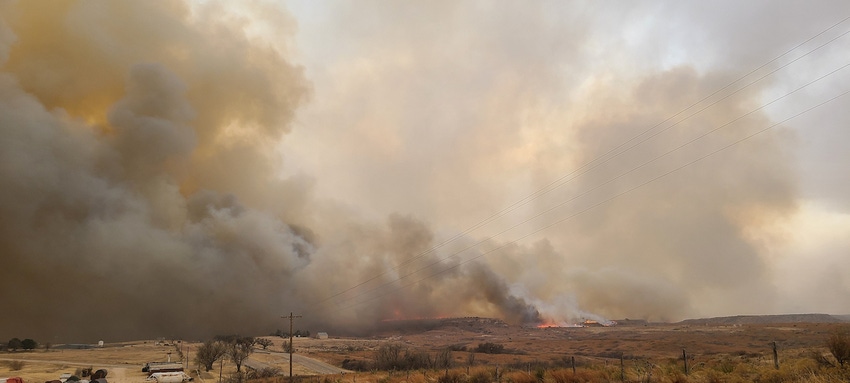Loss, damage ‘catastrophic’ in Texas as fire crews make progress
Homes, properties and thousands of cattle lost or damaged in the Panhandle fires.

Texas A&M Forest Service Blue Team Operations Section Chief Mike Brod said in a Monday morning update that crews had another “really good, productive day” on the fire line Sunday as they continued to control and mop up the fire perimeters of several Texas Panhandle wildfires. In addition to the Smokehouse Creek Fire, which last week became the largest wildfire in the state’s history and the second-largest wildfire in the nation’s history, 56 wildfires have burned more than 1.26 million acres in the state since Feb. 25.
Brod said there were a couple of flare ups in the Smokehouse Creek Fire on Sunday and a new fire that burned 300 acres started between the Windy Deuce Fire and Smokehouse Creek Fire, but “really good work was accomplished, forward progress was stopped, and our crews staffed that fire throughout the night to make sure it stayed within its containment boundaries.”
On Monday, crews were continuing to mop up and patrol the fire perimeters of several fires, Brod said. “We hope to have an aerial recon where we can get some of our operational folks in the air to take a look. It’s a very large fire perimeter, particularly on the Smokehouse [Creek Fire], so we’re going to utilize the aviation to get some eyes in the sky and continue our suppression efforts.”
Although the fire is still only 15% contained, expansion of acres burned in Smokehouse Creek Fire slowed over the weekend, increasing from 1.075 million acres to 1.077 million acres burned.
Loss and damage catastrophic
Texas A&M AgriLife Extension Service said homes and other property have been destroyed and many more have sustained smoke damage. Texas Agriculture Commissioner Sid Miller reported Friday that cattle and crop losses in the Panhandle are significant and infrastructure damage is “catastrophic.” Even those Texans fortunate enough to save their herd may not have anything to return to but ashes, he said.
Hemphill County alone has reported over a thousand missing or dead cattle and several dead horses, goats, and sheep. Numbers in Hemphill County and other impacted areas are expected to rise as the smoldering fire subsides and assessment can be conducted,” Miller noted.
“I pledge my ongoing support for our neighbors who have a long road ahead to recovery from this disaster,” Commissioner Miller said. “I know of ranchers who have lost everything. Our agency will continue its efforts to do everything we can through our STAR Fund, AgriStress Helpline, Hay Hotline, and by partnering with other agencies to lend a helping hand.”
Texas A&M AgriLife Extension Service said that the number one need for livestock owners affected by the wildfires is fencing supplies, closely followed by hay. More information on how to help recovery efforts is here.
Surrounding communities, organizations, and people all across the nation have stepped up to donate hay and feed resources, to support emergency responder needs, and have provided transportation to haul livestock and hay as needed.
Texas has temporarily suspended oversize/overweight permitting requirements for vehicles and loads associated with activities necessary to respond to the disaster and has set up livestock supply points. Additionally, the Texas Animal Health Commission (TAHC) has facilitated a waiver of animal movement documentation for livestock producers because of the 2024 Texas Panhandle wildfire.
“I am immensely grateful for the unity and generosity shown by Texans during this challenging time,” Commissioner Miller said. “The unwavering support and assistance I’ve witnessed is a testament to the strength of our state. I extend my heartfelt appreciation to the emergency personnel and all those who have selflessly united to aid those affected by the wildfires.”
For those seeking assistance or wishing to provide support, Texas Department of Agriculture resources and information on how to help can be found here.
Those in emergency need of hay to feed livestock should visit TDA’s Hay Hotline here.
More information on how to donate or on the STAR Fund can be found here.
To access TDA’s AgriStress Helpline, please call 833-897-2474 or follow this link.
Texas & Southwestern Cattle Raisers Association (TSCRA) is urging donors to give to the TSCRA Disaster Relief Fund to aid victims of the ongoing natural disasters.
“A fire is one of the most tragic events that can impact ranches, and a natural disaster such as the widespread wildfires in Texas and Oklahoma can result in financial hardships and deep impacts to our ranching communities,” said TSCRA President Arthur Uhl. “Texas & Southwestern Cattle Raisers Association is here to help through means of financial assistance and we’re encouraging those who can to donate to the TSCRA Disaster Relief Fund.”
More information on how to donate and how to apply for funding is available here, or by contacting TSCRA at 800-242-7820.
For producers affected by the wildfires, Texas A&M AgriLife Extension Service has resources on post-fire management available here.
“All may appear lost, but with time and rain, pastures burned by recent wildfires will come back stronger if cattle are not restocked too early,” it said. “The loss of standing vegetation affects not only the availability of feed for livestock, but also feed and cover, including nesting habitat for wildlife. The fire also removed litter and standing vegetation that protected the soil from water and wind erosion.”
Recovery may take a few months to a couple of years, depending on the climate and management of the areas, it added. “Management should focus on maintaining and improving plant vigor, rebuilding soil protection, and allowing for recovery of wildlife habitat and forage for livestock production.”
About the Author(s)
You May Also Like




.png?width=300&auto=webp&quality=80&disable=upscale)
